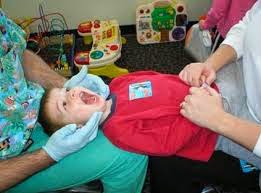
In the first part of this blog we discussed finding a child-friendly dentist and how to help your child before an appointment.
Maybe you have a dental appointment approaching. How can both you and your dentist make things easier for your child during their visit? How can the dentist help my child?
Young children are not able to sit still or concentrate for long periods of time, so visits are best kept shorter or have breaks when needed.Taking things one step at a time will help to build up confidence. It is usually best to start with a check-up and simple cleaning before moving onto other treatment.
- The dentist may introduce a “stop signal,” like raising a hand, that can be used so that your child can let the dentist know if they are not comfortable or need a break.
- Distraction can be used to give your child something else to think about other than the dental treatment. For example, music, cartoons on a TV screen or simply chatting about something else.
- A good dentist will explain things in a way that your child can understand as they go along. Long explanations and words may be confusing for your child. It is best to have a separate chat with parents while the child plays it the waiting room if required.
- The dentist can first explain, and then demonstrate any tools or materials before using them. For example, an instrument can be used on the back of the hand or finger nail before it is used in the mouth so your child knows what it feels like.
- Although the dentist should be friendly with your child they may need to use a sterner tone of voice if a child is not listening and following instructions much the same as a schoolteacher would.
- Positive Reinforcement – when a child behaves and cooperates well they should be rewarded with praise, stickers, a small gift or “bravery” certificate.
Should parents stay in the room for dental treatment?
This depends on your child’s age and behaviour. Young children (below 4 years) tend to experience separation anxiety and therefore it is usually advised that parents stay in the room.
Some children “play up” to their parents and behave better when they are not in the room. One solution for this is to allow the parent or carer to stay in the treatment room whilst the child behaves well, but ask them to go to the waiting room if the child is not listening and following instructions.
How can I help my child during a dental visit?
- In the previous post we discussed the importance of staying positive and encouraging your child.
- For young children, you may need to help support your child on your lap while that dentist checks their teeth as shown in the picture.
- If your child makes a fuss try to remain calm. Dentists who treat children regularly will have seen their share of tantrums and be prepared for this. Allow the dentist to guide you on how to best support you child.
- Some children will “act up” at the dentist to try to avoid treatment. If they are immediately taken out of the treatment room they are more likely to do the same thing the next time. Instead it should be explained to the child what needs to be accomplished in that visit. If cooperation is difficult it is better to achieve a lesser goal than planned, for example, placing a temporary filling, than abandon treatment altogether.
It is better to use rewards after the treatment is over than to promise bribes before hand.
Show your child how proud you are of them for each new achievement.
Finally – Prevention is better than cure
Although, with some help, the majority of children can learn to cope with (or maybe even enjoy!) visiting the dentist the goal should be to prevent the need for dental treatment as far as possible.
It’s a great feeling to take your child for a check up and be told that there are no cavities
Here are some tips for preventing dental decay and gum disease:
- Thorough tooth brushing twice a day, morning and night. For more brushing tips see this post (click for link).
- Rinsing out the mouth with water after eating.
- Eating a healthy diet and making snacks and drinks, between meals, sugar free as far as possible.
- Dental sealants are a coating placed on the biting surface of the back molar teeth by a dentist. They protect the narrow pits and grooves of the tooth which can be prone to decay.
- Regular check-ups not only get your child used to visiting the dentist but enable any early signs of dental disease to be spotted and prevented from progressing into a bigger problem.


